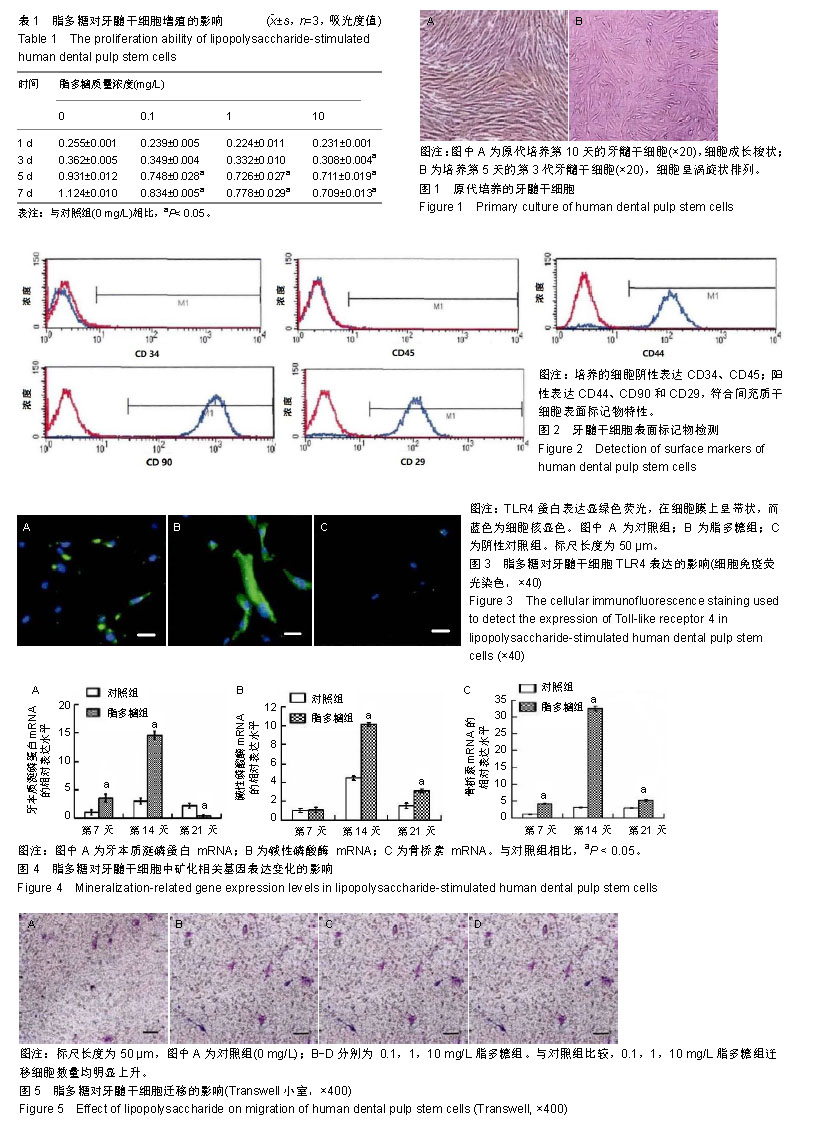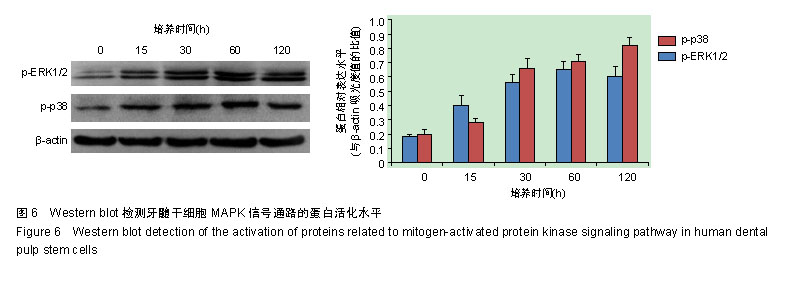中国组织工程研究 ›› 2019, Vol. 23 ›› Issue (29): 4688-4693.doi: 10.3969/j.issn.2095-4344.1801
• 干细胞移植 stem cell transplantation • 上一篇 下一篇
脂多糖可影响及调控牙髓干细胞的增殖与迁移
冯儒学1,蔡仁刚2,解丹丹3
- 1海南省干部疗养院(海南省老年病医院)口腔科,海南省海口市 571100;2文昌市人民医院口腔科,海南省文昌市 571300;3海南医学院第一附属医院营养科,海南省海口市 570102
Lipopolysaccharide can influence and regulate proliferation and migration of dental pulp stem cells
Feng Ruxue1, Cai Rengang2, Xie Dandan3
- 1Dental Department, Cadre Sanatorium of Hainan (Geriatric Hospital of Hainan), Haikou 571100, Hainan Province, China; 2Department of Stomatology, Wenchang People’s Hospital, Wenchang 571300, Hainan Province, China; 3Department of Clinical Nutrition, the First Affiliated Hospital of Hainan Medical University, Haikou 570102, Hainan Province, China
摘要:
文章快速阅读:
.jpg)
文题释义: 人牙髓干细胞:来源于人体牙髓的一类具有自我增殖、分化能力的干细胞,由于具有高度的分化能力和自我增殖能力等生物学特性而受到干细胞研究者的极大关注。另外,由于具有非侵入性取材和获取途径相对简单等特点,其被认为在医学领域具有巨大的潜在应用价值。 活化的丝裂原活化蛋白激酶信号通路:是众多信号蛋白的一种,其激活调控一系列细胞活动。活化的丝裂原活化蛋白激酶通过磷酸化核转录因子、细胞骨架蛋白及酶类等参与细胞增殖、分化、转化及凋亡的调节,并与炎症、肿瘤等多种疾病的发生密切相关。
摘要
背景:大量研究证明人牙髓干细胞是一种具有高度自我更新能力以及多向分化潜能的细胞。
目的:研究脂多糖激活人牙髓干细胞后对细胞增殖及迁移的影响,并探索脂多糖对TLR4、矿化相关基因及MAPK信号通路的影响。
方法:脂多糖模拟深龋时细菌入侵牙髓的微环境。取人牙髓组织,采用组织块酶消化法分离培养人牙髓干细胞,①以0,0.1,1,10 mg/L脂多糖干预1,3,5,7 d,以MTT法检测脂多糖对人牙髓干细胞增殖能力;②将第3代人牙髓干细胞分为对照组和1 mg/L脂多糖处理组,以细胞免疫荧光检测牙髓干细胞中Toll样受体4的表达,以反转录PCR检测矿化相关基因碱性磷酸酶、牙本质涎磷蛋白和骨桥素mRNA表达变化;③取0.1,1,10 mg/L脂多糖干预24 h牙髓干细胞,以Transwell小室检测细胞的迁移能力;④以1 mg/L脂多糖刺激牙髓干细胞0,15,30,60,120 min,以Western blot检测促分裂原活化蛋白激酶信号通路的蛋白p38及ERK1/2的活化水平。实验方案经海南省干部疗养院伦理委员会批准(伦理审批号:20180410)。
结果与结论:与对照组(0 mg/L脂多糖)相比,脂多糖组细胞增殖能力均下降,人牙髓干细胞中Toll样受体4表达增加,矿化相关基因牙本质涎磷蛋白、骨桥素和碱性磷酸酶mRNA的表达水平增加,迁移细胞数量增加,且随着脂多糖作用时间的延长被激活的p-p38及p-ERK1/2蛋白表达随之增强。提示脂多糖对牙髓干细胞的增殖能力、迁移能力有不同程度影响,且Toll样受体4以及促分裂原活化蛋白激酶信号通路蛋白可能参与脂多糖调控的牙髓干细胞定向分化过程。
中国组织工程研究杂志出版内容重点:干细胞;骨髓干细胞;造血干细胞;脂肪干细胞;肿瘤干细胞;胚胎干细胞;脐带脐血干细胞;干细胞诱导;干细胞分化;组织工程
ORCID: 0000-0002-2759-7746(冯儒学)
中图分类号:


.jpg)
.jpg)